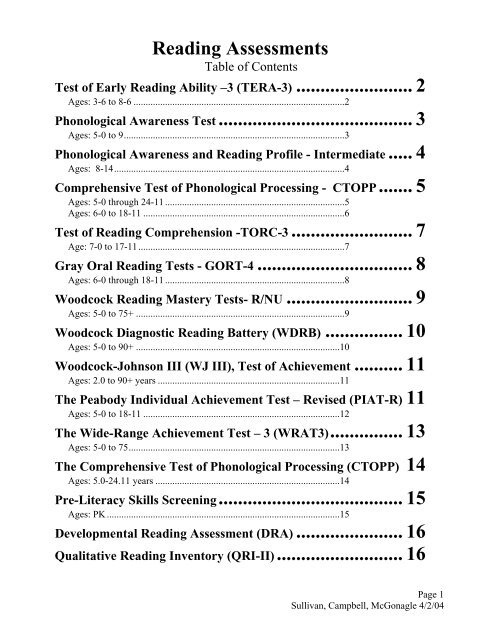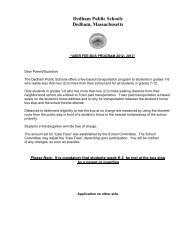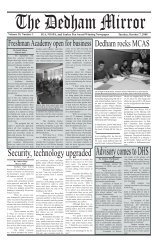Reading Assessments Phonological Awareness Test ...
Reading Assessments Phonological Awareness Test ...
Reading Assessments Phonological Awareness Test ...
You also want an ePaper? Increase the reach of your titles
YUMPU automatically turns print PDFs into web optimized ePapers that Google loves.
<strong>Reading</strong> <strong>Assessments</strong>Table of Contents<strong>Test</strong> of Early <strong>Reading</strong> Ability –3 (TERA-3) ........................ 2Ages: 3-6 to 8-6 .......................................................................................2<strong>Phonological</strong> <strong>Awareness</strong> <strong>Test</strong> ........................................ 3Ages: 5-0 to 9...........................................................................................3<strong>Phonological</strong> <strong>Awareness</strong> and <strong>Reading</strong> Profile - Intermediate ..... 4Ages: 8-14...............................................................................................4Comprehensive <strong>Test</strong> of <strong>Phonological</strong> Processing - CTOPP....... 5Ages: 5-0 through 24-11 ..........................................................................5Ages: 6-0 to 18-11 ...................................................................................6<strong>Test</strong> of <strong>Reading</strong> Comprehension -TORC-3 ......................... 7Age: 7-0 to 17-11.....................................................................................7Gray Oral <strong>Reading</strong> <strong>Test</strong>s - GORT-4 ................................ 8Ages: 6-0 through 18-11 ..........................................................................8Woodcock <strong>Reading</strong> Mastery <strong>Test</strong>s- R/NU .......................... 9Ages: 5-0 to 75+ ......................................................................................9Woodcock Diagnostic <strong>Reading</strong> Battery (WDRB) ................ 10Ages: 5-0 to 90+ ....................................................................................10Woodcock-Johnson III (WJ III), <strong>Test</strong> of Achievement .......... 11Ages: 2.0 to 90+ years ...........................................................................11The Peabody Individual Achievement <strong>Test</strong> – Revised (PIAT-R) 11Ages: 5-0 to 18-11 .................................................................................12The Wide-Range Achievement <strong>Test</strong> – 3 (WRAT3)............... 13Ages: 5-0 to 75.......................................................................................13The Comprehensive <strong>Test</strong> of <strong>Phonological</strong> Processing (CTOPP) 14Ages: 5.0-24.11 years ............................................................................14Pre-Literacy Skills Screening...................................... 15Ages: PK ................................................................................................15Developmental <strong>Reading</strong> Assessment (DRA) ...................... 16Qualitative <strong>Reading</strong> Inventory (QRI-II).......................... 16Page 1Sullivan, Campbell, McGonagle 4/2/04
<strong>Test</strong> of Early <strong>Reading</strong> Ability –3 (TERA-3)The TERA-3 is an instrument primarily used with children in preschool through second grade tomeasure their reading ability. Instead of assessing children’s readiness for reading, it assesses theirmastery of early developing (i.e., emerging)reading skills.Grades:• PreK to grade 2Ages: 3-6 to 8-6• Sub-<strong>Test</strong>so Alphabet (knowledge andletter-sound correspondence)o Conventions (of print)o Meaning (comprehension of words, sentence, and paragraphs)Time: 15-20 minuteshttp://www.agsnet.com/templates/productview.asp?Market=36&Category=346&Group=a19070Page 2Sullivan, Campbell, McGonagle 4/2/04
<strong>Phonological</strong> <strong>Awareness</strong> <strong>Test</strong>The <strong>Phonological</strong> <strong>Awareness</strong> <strong>Test</strong> is an individually administered test designed to diagnosedeficits in phonological processing and phoneme-grapheme correspondence.Ages: 5-0 to 9• Subtests:o Rhymingo Segmentationo Isolationo Deletiono Substitutiono Blendingo Graphemeso Decodinghttp://www.linguisystems.com/itemdetail.php?id=26&linguisystems=6a2fc51699634f6e9d08a7b26d745c81Page 3Sullivan, Campbell, McGonagle 4/2/04
<strong>Phonological</strong> <strong>Awareness</strong> and <strong>Reading</strong> Profile - IntermediateThis profile helps identify several areas in which a struggling reader may experience difficulty.<strong>Test</strong> items assess phonological awareness, phonics knowledge, naming speed and fluency.Although deciding which task to administer to a particular student is left to the discretion of theexaminer, experience shows that it is helpful to obtain as complete a “picture” of a student’sstrengths and weakness as possible. It is also important to note that The <strong>Phonological</strong> <strong>Awareness</strong>and <strong>Reading</strong> Profile-Intermediate is not a comprehensive assessment of reading skills, but ratherserves to complement other measures of reading ability. The <strong>Phonological</strong> <strong>Awareness</strong> and readingProfile-Intermediate provides specific information in the following areas:Ages: 8-14Grades 3-8Time: 20 – 35 minutes• <strong>Phonological</strong> <strong>Awareness</strong>• Phonics• Naming Speed• <strong>Reading</strong> Fluencyhttp://www.linguisystems.com/itemdetail.php?id=341Page 4Sullivan, Campbell, McGonagle 4/2/04
Comprehensive <strong>Test</strong> of <strong>Phonological</strong> Processing - CTOPPThis test assesses phonological awareness, phonological memory, and rapid naming. Persons withdeficits in one or more of these kinds of phonological processing abilities may have more difficultylearning to read than those who do not. The CTOPP was developed to aid in the identification ofindividuals from kindergarten through college who may profit from instructional activities toenhance their phonological skills. The CTOPP has four principal uses: (a) to identify individualswho are significantly below their peers in important phonological abilities, (b) to determinestrengths and weakness among developed phonological processes, (c) to document an individual’sprogress in phonological processing as a consequence of special intervention programs, and (d) toserve as a measurement device in research studies investigating phonological processing.Grades:• K through graduate schoolAges: 5-0 through 24-11<strong>Test</strong>ing Time: 30 minutesSubtests• Elision• Blending Words• Sound Matching• Memory for Digits• Nonword Repetition• Rapid Object Naming• Blending Nonwords• Phoneme Reversal• Segmenting Words• Segmenting Nonwordshttp://www.earobics.com/products/ctopp.cfmPage 5Sullivan, Campbell, McGonagle 4/2/04
Kaufman <strong>Test</strong> of Educational Achievement (KTEA)This test is individually administered measure of the school achievement of children andadolescent in grades 1-12. It offers age based norms as well as grade and comprises two separateand non-overlapping forms: a Brief Form that offers reliable standard scores in the global areas of<strong>Reading</strong>, Math and Spelling and a Comprehensive Form that provides reliable scores in the morespecific domains of <strong>Reading</strong> Decoding, <strong>Reading</strong> Comprehension, Math application, MathComputation, and Spelling. Both forms offer norm-referenced measurement in selectedachievement domains, and the comprehensive Form also provides criterion-referenced assessmentin the analysis of students’ errors in the various content areas.Ages: 6-0 to 18-11Grades: 1 to 12Time: 20 minutes to 65 minutesSubtests:• Math Application• <strong>Reading</strong> Decoding• Spelling• <strong>Reading</strong> ComprehensionPage 6Sullivan, Campbell, McGonagle 4/2/04
<strong>Test</strong> of <strong>Reading</strong> Comprehension -TORC-3The TORC-3 represents the operationalization of a constructivist orientation thatfocuses on holistic, cognitive, and linguistic aspects of reading. The test compriseseight subtest grouped under the General Residing Comprehension Core (whichyields a <strong>Reading</strong> Comprehension Quotient (RCQ) that can be compared to measuresof abstract thinking, oral language abilities, and achievement) and DiagnosticSupplements.Grade: 2-12Age: 7-0 to 17-11Time: 30 minutesSubtests:• General Vocabulary• Syntactic Similarities• Paragraph <strong>Reading</strong>• Sentence Sequencinghttp://www.linguisystems.com/itemdetail.php?id=302Page 7Sullivan, Campbell, McGonagle 4/2/04
Gray Oral <strong>Reading</strong> <strong>Test</strong>s - GORT-4The GORT-4 is a norm-referenced, reliable, and valid test of oral reading rate, accuracy, fluencyand comprehension. The GORT-4 has two parallel forms, Form A and Form B, each containing14 separate stories. Five multiple-choice comprehension questions follow each story.Performance on the GORT-4 yields the following scores on the subtests.Grades:1-12+Ages: 6-0 through 18-11<strong>Reading</strong> Sub-<strong>Test</strong>• Rate• Accuracy• Fluency• Comprehension• Overall <strong>Reading</strong> AbilityIn addition, the GORT-4 provides a system forperformingan analysis of the types of oral reading miscues made in 5areas:• Meaning Similarity• Function Similarity• Graphic/Phonemic Similarity• Multiple Sources• Self-Correctionhttp://www.linguisystems.com/itemdetail.php?id=301Page 8Sullivan, Campbell, McGonagle 4/2/04
Woodcock <strong>Reading</strong> Mastery <strong>Test</strong>s- R/NUThe Woodcock <strong>Reading</strong> Mastery <strong>Test</strong>s-Revised/Normative Update (WRMT-R/NU) is acomprehensive battery of tests measuring important aspects of reading ability. The Total <strong>Reading</strong>Cluster--Full Scale is a broad measure of reading ability useful in comparing a person's overallreading ability with other individuals in the same grade or at the same age. <strong>Reading</strong> readiness,basic reading skills, and reading comprehension can also be assessed with this measure.Grades:• K.0 to collegeAges: 5-0 to 75+• Sub-<strong>Test</strong>so Visual-Auditory Learningo Letter Identificationo Word Identificationo Word Attacko Word Comprehensiono Antonymso Synonymso Analogieso General <strong>Reading</strong> Vocabularyo Science-Math Vocabularyo Social Studies Vocabulary10-30 minutes for each cluster of testshttp://www.agsnet.com/templates/productview.asp?Market=36&Category=346&Group=a16640Page 9Sullivan, Campbell, McGonagle 4/2/04
Woodcock Diagnostic <strong>Reading</strong> Battery (WDRB)The WDRB provides diagnostic insights of reading aptitude and achievement. It is acomprehensive, individually administered test of reading aptitude and achievement which can beused to determine reasons for a student's strengths or weaknesses in reading. A wide variety ofscores lead to many interpretation options including: <strong>Reading</strong> Aptitude, <strong>Reading</strong> Comprehension,<strong>Reading</strong> Basic Skills, <strong>Reading</strong> Achievement Total, <strong>Phonological</strong> <strong>Awareness</strong>, Oral Comprehension,and <strong>Reading</strong> Aptitude/Achievement Discrepancy.Grades:• K.0 to 16.9Ages: 5-0 to 90+• Subtests:<strong>Reading</strong> Aptitude:o Memory for Sentenceso Visual Matchingo Sound Blending*o Oral Vocabulary<strong>Reading</strong> Achievement:o Letter-Word IDo Passage Comprehensiono Word Attacko <strong>Reading</strong> VocabularyOptional <strong>Test</strong>s:o Incomplete Words*o Listening Comprehension**Taped <strong>Test</strong>s (audiocassette included)Administration Time50-60 minutes for all 10 subtestshttp://www.riverpub.com/products/clinical/wdrb_ach/home.htmlPage 10Sullivan, Campbell, McGonagle 4/2/04
Woodcock-Johnson III (WJ III), <strong>Test</strong> of AchievementPractitioners can now use the WJ III ® <strong>Test</strong>s of Achievement to help to assess students for learningdisabilities and to determine if they are eligible for special services. The Individuals withDisabilities Act (IDEA) is federal legislation that defines the terms under which students may bedeclared eligible for special services. According to IDEA, students are defined as learning disabledif they have a severe discrepancy between intellectual ability and achievement in one or more ofthe areas listed in the chart on the right. The WJ III <strong>Test</strong>s of Achievement includes clusters thatdirectly parallel these IDEA areas. Each cluster provides sound procedures for determiningdiscrepancies between a student's abilities and achievement in each area.Grades:• K.0 to graduate schoolAges: 2.0 to 90+ years• <strong>Reading</strong> Sub-<strong>Test</strong>so Letter-Word IDo <strong>Reading</strong> Fluencyo Story Recallo Understanding Directionso Passage Comprehensiono Story Recall – Delayedo Word Attacko Picture Vocabularyo Oral Comprehensiono <strong>Reading</strong> VocabularyAdministration TimeVaries, about 5 minutes per testhttp://www.riverpub.com/products/clinical/wj3_ach/home.htmlThe Peabody Individual Achievement <strong>Test</strong> – Revised (PIAT-R)Page 11Sullivan, Campbell, McGonagle 4/2/04
The Peabody individual Achievement <strong>Test</strong> – Revised (PIAT-R) is an individually administeredachievement test providing wide-range assessment in six content areas: General Information,<strong>Reading</strong> Recognition, <strong>Reading</strong> Comprehension, Mathematics, Spelling, and Written Expression.Ages: 5-0 to 18-11• <strong>Reading</strong> Subtests:o <strong>Reading</strong> Recognition (letter-soundand words)o <strong>Reading</strong> Comprehension (readsentence, choose picture thatmatches)Administration Time: 60 minuteshttp://www.agsnet.com/productview.asp?group=a29060Page 12Sullivan, Campbell, McGonagle 4/2/04
The Wide-Range Achievement <strong>Test</strong> – 3 (WRAT3)Measuring the development of reading, spelling, and arithmetic skills, the WRAT3 identifies thelevel of coding performance and helps to identify learning disabilities in reading, spelling, andarithmetic when used in conjunction with a comprehensive test of general ability.Ages: 5-0 to 75• <strong>Reading</strong> Subtests:o <strong>Reading</strong>--recognizing and namingletters, pronouncing printed words<strong>Test</strong> administration: Each form is 15 to 30 minutes, depending on age.http://www.widerange.com/wrat3.htmlPage 13Sullivan, Campbell, McGonagle 4/2/04
The Comprehensive <strong>Test</strong> of <strong>Phonological</strong> Processing (CTOPP)Identifies individuals from kindergarten through college who may profit from instructionalactivities to enhance their phonological skills.The <strong>Phonological</strong> <strong>Awareness</strong> Quotient (PAQ) measures anindividual’s awareness and access to the phonological structure oforal language.The <strong>Phonological</strong> Memory Quotient (PMQ) measures theexaminee’s ability to code information phonologically fortemporary storage in working or short-term memory.The Rapid Naming Quotient (RNQ) measures the examinee’s efficient retrieval of phonologicalinformation from long-term or permanent memory, as well as the examinee’s ability to execute asequence of operations quickly and repeatedly.Ages: 5.0-24.11 years• CTOPP Subtests:o Elisiono Blending Wordso Sound Matchingo Memory for Digitso Nonword Repetitiono Rapid Color Namingo Rapid Digit Namingo Rapid Letter Namingo Rapid Object Namingo Blending Nonwordso Phoneme Reversalo Segmenting Wordso Segmenting Nonwords<strong>Test</strong>ing Time: 30 minutes, for core subtestshttp://www.earobics.com/products/ctopp.cfmPage 14Sullivan, Campbell, McGonagle 4/2/04
Pre-Literacy Skills ScreeningThe Pre-Literacy Screening assesses phonological awareness, letter recognition, and word-retrievalthat are essential to reading achievement in young children. The PLSS is a quick (15 minute),informal assessment of these skills.Ages: PK• Preschool• Subtests:o Rhymingo Namingo Sentence Repetitiono Blendingo Letter Namingo Deletiono Sentence Segmentationo Syllable Segmentationo Multisyllabic WordRepetitionAdministration Time: 15 minuteshttp://www.imaginartonline.com/7000/7245.shtmlPage 15Sullivan, Campbell, McGonagle 4/2/04
Developmental <strong>Reading</strong> Assessment (DRA)The Developmental <strong>Reading</strong> <strong>Assessments</strong> (DRA) are conducted during one-to-one readingconference as children read specially selected assessment texts. The DRA assesses the student’sability to preview text and predict what might happen, detect and correct errors, and problem solveunknown words flexibly and automatically while reading. The DRA looks for reading behaviorssuch as pausing, rereading, searching the pictures, appealing for help, sounding out clusters ofletters, and self-correcting as evidence of the student’s use of various strategies.Qualitative <strong>Reading</strong> Inventory (QRI-II)The QRI-II is an individually administered informal reading inventory designed to providediagnostic information about:1. Conditions under which students can identify words and comprehend text2. Conditions that appear to result in unsuccessful word identification, decoding, and/orcomprehensionThe QRI-II is an inventory that contains word lists and passages at pre-primer through junior highlevels. It includes both narrative and expository passages. The QRI-II evaluates comprehensionby an analysis of retelling and questions. The QRI-II measures prior knowledge, differencesbetween oral and silent reading, and use of reading strategies, word identification speed and rate ofreading.Ages:• Pre-primer through junior high schoolAdministration time: varies, depending upon agePage 16Sullivan, Campbell, McGonagle 4/2/04






